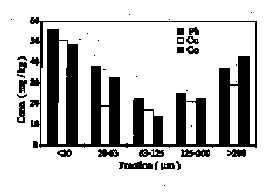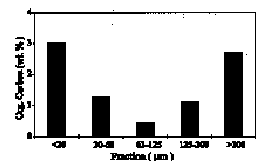
Gangetic Plain is one of the most densely populated regions of the world and houses 1/3rd of its population. The main resource of this plain is agriculture depending heavily on water. Alarming population growth, unplanned urbanization and rapid industrialization in this plain, have caused various geoenvironmental hazards especially enhanced metal pollution in stream sediments and soils of agricultural land. In present research study metal concentrations of Cd, Co, Cr, Cu, Li, Ni, Pb, Sr, V, Zr, Zn and organic carbon on different grain size fractions ( <20 mm, 20-63 mm, 63-125 mm, 125-200 mm and >200 mm ) of sediments were analyzed. In present publication, concentrations of Co, Cu, Pb and organic carbon on grain size fractions have been taken as an example.
Average concentrations of Co, Cu and Pb on different fractions are as follows: 40, 115 and 171 mg/kg on >200 mm; 44, 118 and 135 mg/kg on 125-200 mm; 38, 90 and 122 mg/kg on 63-125 mm; 50, 129 and 180 mg/kg on 20-63 mm and 72, 224 and 331 mg/kg on <20 mm. Average values of organic carbon in sediments are 5.2 wt. % on >200 mm, 3.6 wt. % on 125-200 mm, 2.5 wt. % on 63-125 mm, 2.3 wt. % on 20-63 mm and 4.1 wt. % on <20 mm fractions.
Metal concentrations first decrease with increasing grain size and then increase with increasing grain size especially on 125-200 mm and >200 mm particle fractions (Fig.1). Same is the case with organic carbon which also increases with increasing grain size (Fig. 2 ).
It is presumed that increasing percentages of organic carbon in coarser particles may provide active sites for binding and retaining these metals. In addition, coarser fractions contain high amounts of detritic mica which may also provide sites for binding metals. This study reveals that the anthropogenic input to stream sediments of Ganga river and its tributaries should not be estimated by analyzing the grain size fractions <63 mm, but also with the concentrations in coarser fractions. Thus, due to the unusual mineralogical composition of the sediments, metal concentrations of coarser particle size should also be taken into account.
Fig. 1: An example of concentrations of selected heavy metals on grain size fractions.
Fig. 2: An example of organic carbon percentages on grain size fractions.